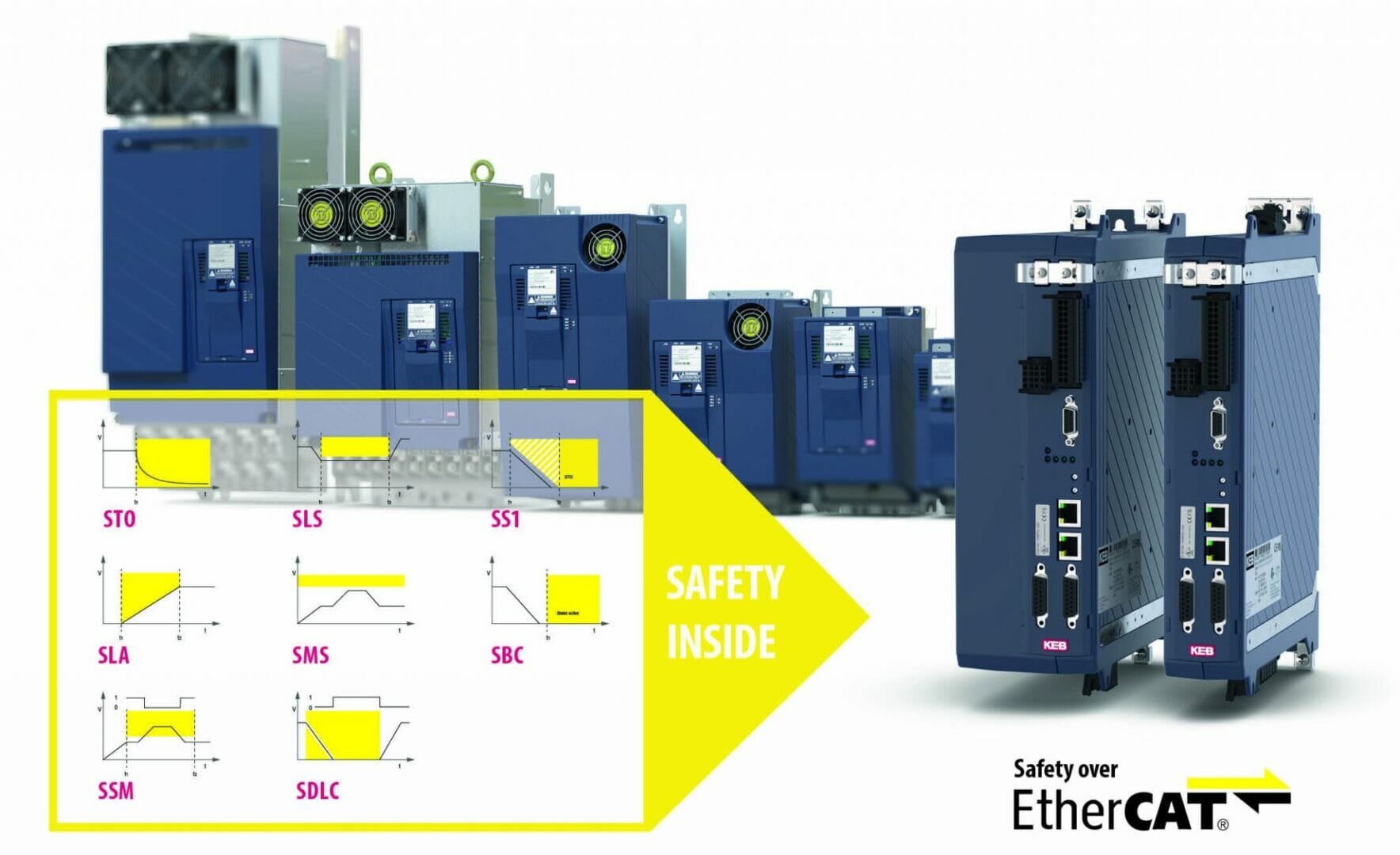What is the goal of functional safety? To minimise the risks posed by technical equipment to humans and the environment. Machine tools, for example, can endanger operators and technicians with tools that rotate at high speeds. Drive technology that ensures the required safety functions without encoders offers the user various advantages, says Mark Checkley of KEB.
The safe operation of machines often requires safety functions to limit speeds, directions of rotation or axis positions. With traditional safety solutions, dangerous operating states are detected and avoided using external safety modules. This increases the complexity of the machine’s safety concept. In contrast, drive controllers with integrated safety functions and safety PLCs including certified function blocks are used today, which reduce the wiring effort and simplify the safety concept. In some applications with compact motors or high-frequency spindle motors, encoder mounting is not possible for safe monitoring functions but, as speed monitoring usually depends on encoder signals, new concepts for safety functions without sensors are necessary. In addition to more individual machine concepts, encoderless safety functions in the drive offer cost effective options for simple drive monitoring and there is also the benefit that maintenance and repair costs can be reduced.
Applications where encoderless safety functions offer advantages:
- For harsh environmental conditions that restrict the use of an encoder.
- In cost-intensive applications with encoderless drive control.
- For switching between several motors on one drive controller.
- No need to implement complex mechanical or electrical measures.
Processing machine as an application example
Encoderless safety functions can be used in various applications. One example is machine tools in the form of CNC machining centres, which can carry out several machining steps on one workpiece. These include turning, milling and drilling machines that are suitable, for example, for the complete machining of materials such as wood, plastic, glass or metal.
The sixth generation of KEB Automation drives offers scalable safety functions directly in the drive controller. The device variants are Compact, Application and Pro for the COMBIVERT F6 and S6, enabling selectable functions according to the requirements.
- In the Compact device variant, Safe-Torque-Off (STO) is integrated as the basic function.
- The Application device variant is available for speed and position-dependent safety functions with encoders. Flexible adaptation of the safety functions and limit values is possible via digital I/Os and/or Safety-over-EtherCAT (FSoE).
- The Pro device variant offers possibilities for implementation in the area of encoderless safety. For example, safe solutions can be implemented in applications where encoder mounting is not possible. This also results in a reduction in costs. The device determines the safe velocity parameters from the pulse width modulation (PWM) of the motor supply. In addition to STO, the Pro variant is equipped with a safe brake control (SBC) which provides a safe 24V supply for braking operation, as well as monitoring of the switching status of the brake via micro switch evaluation. Here, too, the safety functions and limit values can be flexibly adapted via digital I/Os and/or Safety-over-EtherCAT (FSoE). In addition, safe sensorless speed monitoring can be used independently of the motor and therefore for a large number of applications.
Safe machine functions
The following safety functions are available for processing machines:
- SLS (Safely-Limited Speed)
With the SLS function, the drive reliably monitors the speed. If the set speed limit is exceeded, an error reaction occurs, which is defined during project planning. The SLS function protects tools from overspeed.
- SLA (Safely-Limited Acceleration)
For this purpose, the SLA function monitors the acceleration ramps. It prevents the motor from exceeding the defined limits during acceleration.
- SS1 (Safe Stop 1)
The shutdown of the drive is safely monitored by the SS1 function. The torque is then switched off (safety function STO is activated).
- SDCL (Safe Door-Lock Control)
The SDLC function can be used to lock the hood of the machine. This function only opens the hood when the motor has come to a safe standstill (e.g. for tool change).
- SSM (Safe Speed Monitor) and SMS (Safe Maximum Speed)
SSM provides a secure digital signal for speed monitoring with which other plant components can be controlled. SMS permanently monitors a maximum speed without having to activate monitoring.
Another highlight is the eightfold use of each safety function. For example, eight different speed values can be stored in the safety module for the SLS function, which can be selected via safe inputs or via FSoE. Several safety functions can also be combined with just one input. If, for example, the SLS function is to be linked with a safe direction of rotation, this can be conveniently set up. A direct activation of STO can be defined as a reaction to an overspeed during SLS monitoring. Alternatively, an error ramp can be used to shut down and this can be monitored with the SS1 function.
In addition, KEB offers the possibility to operate both the milling and drilling drive with only one COMBIVERT F6/S6 drive controller in the application. The safety part is monitored without an encoder. The respective motors can still be operated with encoder feedback. These two types are not mutually exclusive in the Pro variant. In addition to switching between different motors, it is also possible to switch between different limits for each motor, e.g. in automatic or set-up mode, in order to safely monitor the limits.
Configuration
The configuration of the KEB Safety Drives is carried out using the certified Safety Editor, which is integrated in the KEB set up and configuration environment, COMBIVIS 6. This is where the safety functionality and limits can be configured. These safety-related settings can be saved and downloaded to other drives via COMBIVIS or via the controller. Current parameters and the error history can be used for system diagnosis. The export function makes it easy to create the required documentation.
For more information, please visit www.keb.co.uk








